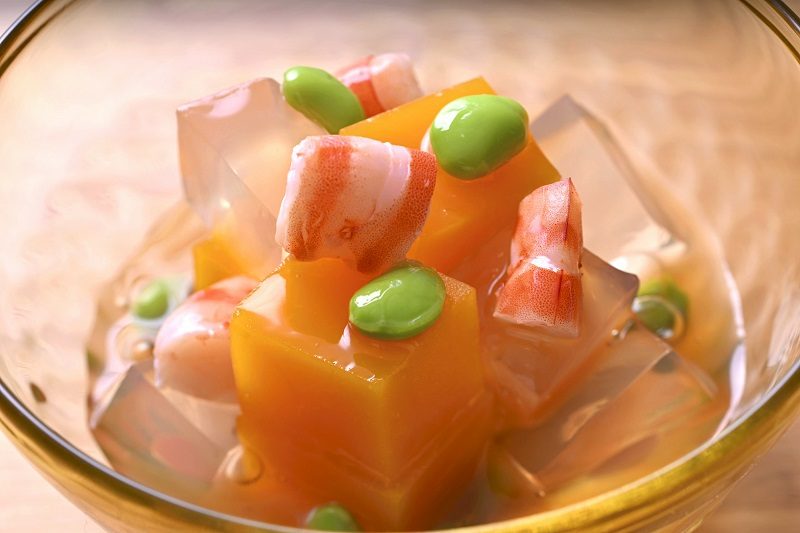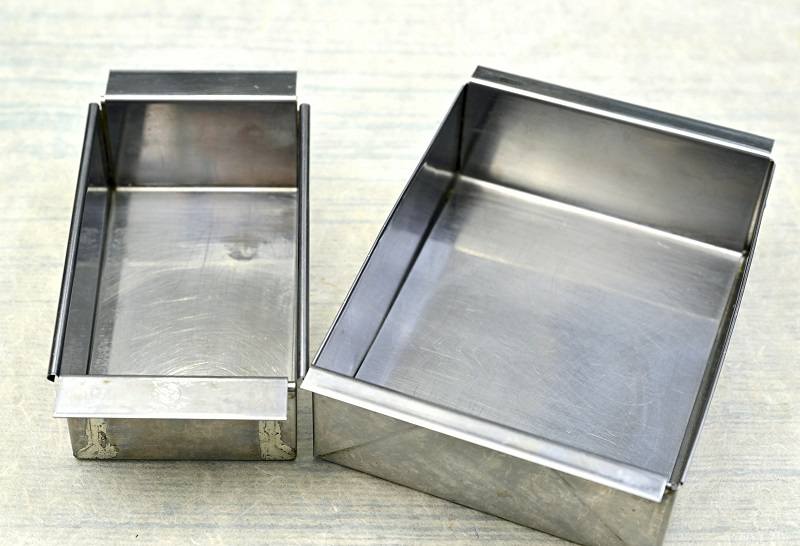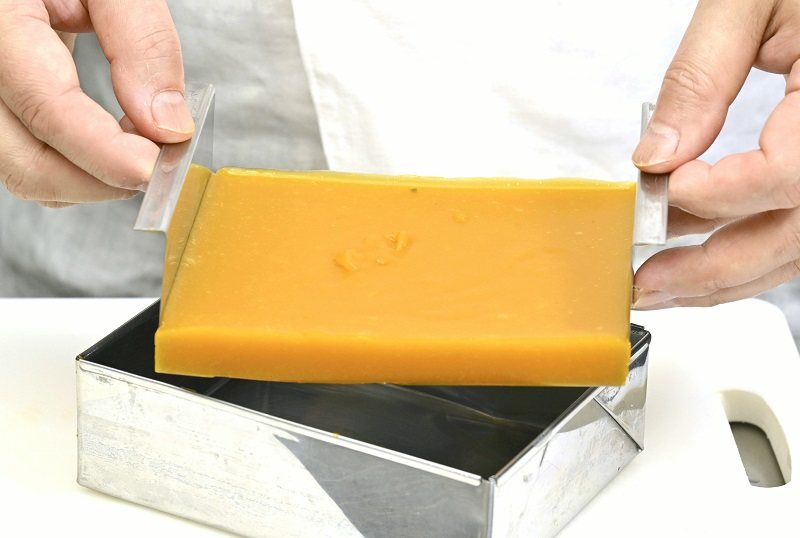Kabocha kanten dish, too good to let slip away

Kabocha pumpkin kanten served anmitsu style
12:00 JST, September 17, 2022
When it’s hot and muggy outside, eating something that slips down the throat is always enjoyable.
Takamitsu Aihara, founder of a cooking school, uses kanten, or agar, to make cubed kabocha pumpkin gelatin that is served like the Japanese dessert anmitsu, which is made using kanten, various fruits and a dark-colored syrup. However, unlike anmitsu, the dish is not sweet but savory, so it can also be served as a side dish.
The kabocha, which is mashed and then solidified using kanten, is covered in a vinegar dressing made using kudzu arrowroot.
The main ingredients are kanten and kudzu, which Aihara often incorporates into the Japanese dishes he teaches students how to make at his school.
“In Japanese cuisine, the texture of food as it goes down your throat, or nodogoshi, is very important,” Aihara said. “When it’s hot, you want something that easily enters your body, and kanten and kudzu are good for that.”
A long time ago, ice was very valuable, so foods were hardened using kanten or kudzu to resemble water or ice, allowing people to feel cooler just by looking at it.
In Aihara’s recipe, kabocha is boiled in broth, then mixed with powdered kanten to make yellow gelatin. Flavorless water kanten is also included, along with other summer ingredients such as edamame and shrimp. Dressed with a tosa brown vinaigrette made using kudzu, the dish looks just like anmitsu.
Preparing kanten and kudzu correctly is the key to making a delicious dish. It is important to thoroughly heat them after mixing them with water.
“If they are not heated properly, the kanten won’t set when cooled and the kudzu becomes cloudy,” Aihara said.
Nagashi-kan

Nagashi-kan molds
A rectangular stainless-steel mold called nagashi-kan is used to hold the kanten as it cools. Aihara used two, each 14 centimeters long, 11 centimeters wide and 4.5 centimeters deep.
“This is a convenient kitchen tool,” he said. “It’s good to have.”
It can also be used in a steamer or in an oven to make such Japanese dishes as egg tofu or matsukaze-yaki (baked ground chicken), he added.
Other containers can be used as an alternative, but nagashi-kan comes in two parts, so once the kanten hardens, it can easily be lifted out from the mold.
“You don’t need a knife or spatula to take the kanten out,” he said.
Vinaigrette dressing
Tosa vinaigrette helps bring all the flavors together. It has an umami flavor from dashi stock and is slightly sour.
“Since it’s summer, I like to add a little more acid to the dish,” Aihara said.
The vinegar is added after the kudzu is dissolved, but you have to be careful not to let the acidity evaporate too much.
The shiny yellow kanten, the green edamame and the red shrimp create an image of a summer jewelry box.
The smooth and refreshing texture of kanten and kudzu slips down my throat and plops in my stomach, which has been slow to digest food as a result of the heat. The kabocha’s mild sweetness pairs well with the slightly sour vinaigrette, cooling us down amid the summer heat.
Kabocha pumpkin kanten served anmitsu-style
Ingredients (serves 4):
- 200 grams kabocha pumpkin
- 400 milliliters dashi broth
- 5 grams kanten agar powder
- Moderate amount of boiled edamame
- 4 headless shrimp
- 10 grams kudzu arrowroot powder
Directions:
1. Remove boiled edamame soybeans from pods. Boil shrimp with a pinch of salt.
2. Peal the kabocha, remove the seeds and clean out the inside. Cut the kabocha into 2- to 3-centimeter cubes and let simmer in 300 milliliters of broth. Skim the surface of the broth to remove the foam and simmer until the kabocha is soft enough to pierce with a skewer. Let cool. Add 200 more milliliters of broth (not included in the list of ingredients) if necessary.

Put the simmered kabocha and dashi into a blender, add sugar, salt and kanten, and mix.
3. Put the simmered kabocha and dashi into a blender, add 1 tablespoon of sugar, ¼ teaspoon of salt and 3 grams of powdered kanten, and mix.
4. Put the blended kabocha back into the pot and keep stirring to prevent it from burning. Continue until it starts to bubble, then turn off the heat. When cool, put the kabocha mixture into a nagashi-kan mold and refrigerate to set.
5. To make transparent kanten, mix 2 grams of powdered kanten, add 300 milliliters of water and heat as described in Step 4. Then let it cool and put it in the refrigerator.
6. To make tosa vinaigrette, put 100 milliliters of broth, 2 tablespoons of light soy sauce and 1 cup of mirin into a pot, then heat. Dissolve the kudzu arrowroot powder in 10 milliliters of water. Add the kudzu mixture to the broth once it comes to a boil and mix thoroughly until it becomes clear. Turn off the heat, then add 2 tablespoons of vinegar and let cool.
7. Remove the two different colored kanten from their molds and cut them into cubes.

Remove the two different colored kanten from their molds and cut them into cubes.
8. Place the kanten, edamame and sliced shrimp into a bowl and pour the vinaigrette on them.



